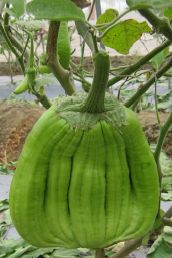- Wheat disease understood; sequence of leaf blotch fungus.
- Wheat disease conquered? “Super varieties” resistant to UG99 and yield 15% more. What could go wrong?
- Zambian farmers urged to dry vegetables for fun and profit (and better nutrition).
- Gates Foundations has spent US$1.7 billion on agriculture in Africa, so far.
- Swaminathan Foundation scores Canadian support for research on agriculture, poverty and nutrition. h/t PAR.
- Bioversity Seeds for Needs distributes preselected genebank wheat varieties to Ethiopian women farmers to adapt to climate change.
Nibbles: Food security, Food carts, Cotton, Ritual, C4 C3 CC, American Indian diets, Community genebanks in India, Fowler, Dark earth soil, Domestication
- German donor examines food and security, notes “the fast loss of biodiversity”.
- Food carts are successful oases in at least one food “desert”.
- Yesterday’s Botany Photo of the Day was American cotton.
- Good news, everyone: “Hardcore farmers prefer lowkey rituals.” Obviously the memo didn’t reach the children of the corn.
- Photosynthesis and climate change: it’s complicated.
- Native Americans try to reclaim control of their foodways. And their waists.
- “…every district should have a community-controlled seed centre with a gene bank for traditional seeds.” Of course it should. “The local available seed diversity needs to be protected and conserved at any cost.” Of course it must.
- “Right now, all over the world, projects are underway to store seeds…“
- Dark earths not just in Amazon, Africa too.
- Presentation on IFAD project on cultivating wild aromatic etc. species for money in Morocco.
Would you eat this eggplant?
 You heard of Buddha’s hands citrus, right? Well, now get a load of Buddha’s hands eggplant.
You heard of Buddha’s hands citrus, right? Well, now get a load of Buddha’s hands eggplant.
Brainfood: Baby’s veggies, Chickpea and drought, Vine cactus breeding, Paleolithic rabbits, California protected areas, Wild pigeonpea, Pecorino classification, Milk composition, Phenotyping, Wild peas
- Vegetables by Stealth: an exploratory study investigating the introduction of vegetables in the weaning period. Sneaking them into the diet is the most common strategy used by mothers to introduce their kids to vegetables. Reeeeeally?
- Assessment of Iranian chickpea (Cicer arietinum L.) germplasms for drought tolerance. Four out of 150 local landraces showed promise. It really is a numbers game, isn’t it?
- In situ induction of chromosome doubling in vine cacti (Cactaceae). Potentially valuable autopolyploids were produced. Not that it was easy or anything.
- Who brought in the rabbits? Taphonomical analysis of Mousterian and Solutrean leporid accumulations from Gruta Do Caldeirão (Tomar, Portugal). People did, that’s who, but only during the later Upper Paleolithic. Before that it was mainly owls.
- Protected areas in climate space: What will the future bring? Nothing good. Both novel and disappearing climates are over-represented in current protected areas, at least in California.
- Progress in the utilization of Cajanus platycarpus (Benth.) Maesen in pigeonpea improvement. Baby steps.
- Classification of pecorino cheeses using electronic nose combined with artificial neural network and comparison with GC-MS analysis of volatile compounds. Wait, there are different kinds of pecorino?
- The need for country specific composition data on milk. Well, you’ve got me convinced.
- Rate-distortion tradeoff to optimize high-throughput phenotyping systems. Application to X-ray images of seeds. So, let me get this straight, basically, gauging the optimal trade-off between speed and accuracy in high-throughput phenotyping systems depends on what you’re measuring? Who writes these grant applications?
- Experimental growing of wild pea in Israel and its bearing on Near Eastern plant domestication. First pea growers were either very patient or very quick workers.
Nibbles: Tamil genebank, Econutrition, Sweet perception, Salmon, Texas culinary diversity, Amaranth, Nepal hermarium video, Restoration
- Provincial Indian university gets a genebank.
- Nutritionists go all ecological on us.
- But does that include taking into account human variation in taste perception? I’m betting no.
- The case against GM salmon.
- Going crazy in Austin’s market.
- Amaranth touted in Kenya. Sorghum and local millets unavailable for comment.
- Take a virtual trip around Nepal’s herbarium.
- Society for Ecological Restoration opens online Early Registration for the 4th World Conference on Ecological Restoration, to be held in August in Mérida, Mexico. You guys need a blogger?